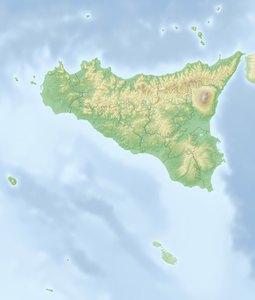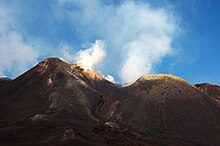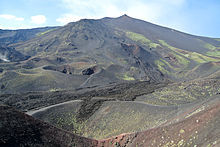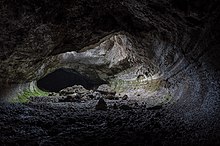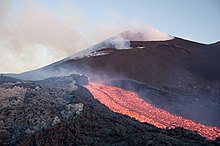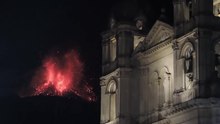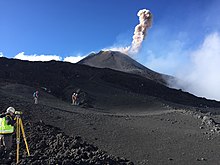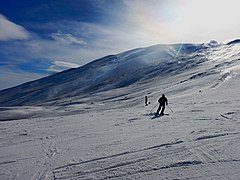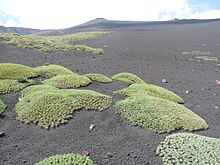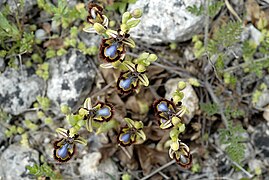Etna
| Etna | ||
|---|---|---|
|
Mount Etna as seen from Catania in winter |
||
| height | 3329 m slm (varies) | |
| location | Italy ( Sicily ) | |
| Dominance | 998 km → Marmolada | |
| Notch height | 3329 m | |
| Coordinates | 37 ° 45 '4 " N , 14 ° 59' 45" E | |
|
|
||
| Type | Stratovolcano | |
| rock | basalt | |
| Age of the rock | Young Pleistocene to Holocene | |
| Last eruption | 2018, ongoing | |
| particularities | highest volcano in Europe and highest mountain in Sicily | |
|
Etna eruption in 2002, photographed from the ISS |
||
The Etna ( Italian Etna or Mongibello ) is approximately 3323 meters above sea level is the highest active volcano in Europe . It is located on the Italian island of Sicily in the administrative unit of the metropolitan city of Catania . On June 21, 2013, UNESCO added Mount Etna to its World Heritage List .
description
Etna was formed about 600,000 years ago on the east coast of Sicily at a point where a bay reached far into the interior and the first submarine volcanic activity occurred a million years ago.
The name is etymologically usually derived from the Indo-European * aidh- ("to burn"). Since the sound shift from "dh" to "t" can neither be derived from the linguistic history of Greek (name ancient Greek Αἴτνη Aitnē ) nor from that of West Italian, it is assumed that the word of the older language class of the original inhabitants of Sicily ( Sikanen ) before the colonization by the Greeks. In colloquial language, Etna also has the name “Mongibello”, derived from Latin “mons” (from which Italian “monte” ) and Arabic “djebel” (جبل), which both simply mean "mountain".
geography
Etna has four summit craters : the main crater, the directly adjacent crater “Bocca Nuova” (new throat) from 1968 as well as the northeast crater from 1911 and the southeast crater from 1979, which are a little off the main crater. In the event of an eruption, however, lava is usually not emitted via the summit crater, but on the flanks of the mountain cone. Over the millennia, around 400 secondary craters have formed as a result, such as B. 1892 the Silvestri Mountains .
The current altitude of Mount Etna cannot be precisely stated as it often changes due to cinder cones and destructive eruptions. The Etna mountain range covers an area of around 1250 square kilometers and is around 250 kilometers in circumference.
geology
Etna, whose volcanic products cover an area of around 1170 square kilometers and a volume of around 530 cubic kilometers, is Europe's largest active volcano. The mountain , which is free on all sides, rises to three times the height of the mountain ranges surrounding it. Naturally, its height does not remain constant. It is between 3200 and 3350 m depending on the consequences of the previous activity .
It is located in a zone of high volcanic and seismic activity caused by the subduction of the African under the European continental plates. Other examples of volcanism caused by this tectonic process are Vesuvius and the Aeolian Islands . While the geohistory of the area is unclear in detail, it seems certain that volcanic activity in Sicily since the middle Pleistocene has concentrated on the area of today's Etna, at the intersection of three fault lines of the aforementioned subduction zone.
Today's Etna rests on an isostatically ascending base of sediments that are Cretaceous to Quaternary in age. On the north-western flank of the mountain, they are not covered by volcanic rocks until 1150 to 1300 meters above sea level . According to this, the relative height of the volcano is only about 2000 meters. Etna lies on the west side of a large northeast-southwest trending regional fault zone known as the Messina Fault . This old lineament is still tectonically active and causes not only the volcanism of Etna, but also the frequent strong earthquakes in this region. In 1693 Catania and 1908 Messina were destroyed by earthquakes.
Years ago, about 600,000 began in Middle Pleistocene of volcanism in the area of today's Mount Etna, the volcanic activity extended over a period of around 300,000 years ago and continue to this day. Volcanic activity initially began with submarine volcanic eruptions that produced hyaloclastites and pillow lavas . The continental shelf on which Mount Etna rises today was a large sea bay at that time. Only later did the land rise.
The construction of the actual stratovolcano complex, however, only began about 100,000 years ago. The older Mongibello stage , in which the older part of today's Etna was formed, is set in the end of the Pleistocene around 10,000 to 8,000 years ago, while the younger Mongibello stage , that of the volcano that is still active today, began at least 3000 years ago. These dates are mostly based on radiocarbon dating of spilled organic materials.
More than 300 parasitic, adventurous or flank volcanoes sit on the flanks of the mountain . By far most of them originated in the younger Mongibello stage. Even today, new flank volcanoes are created time and again with larger eruptions. Most are in the altitude range between 700 and 2500 meters, with the altitude around 1800 meters being the densest. The lowest cone is at a height of 370 meters.
Typical of the Etna are eruptions along aufreißender columns . With the exception of the volcano's permanent activity, which is limited to the summit area, almost all historical eruptions were linked to such eruption fissures. The length of these crevices varies from a few hundred meters to several kilometers. In the course of an eruption, the crevices usually tear open further and further downwards, whereby in the higher areas mostly pure cinder cones arise, in contrast lava flows out in lower areas .
The basic lava of Etna is usually relatively thin due to a small amount of silica. This allows the gases contained in it to escape and does not build up any excess pressure that could be discharged in an explosion. Therefore, Etna is not one of the explosive volcanoes like Vesuvius, for example . However, this opinion has recently had to be put into perspective and it has been established that Etna has also had explosive eruptions in the past, such as that of 122 BC. BC, a Plinian eruption .
Due to the relatively thin liquid lava, there is a unique phenomenon among the mainland European volcanoes on Etna, the lava grottoes . They are created by a lava flow cooling rapidly on its surface, while the lava inside it is still flowing away. This creates tunnels that can reach a length of several hundred meters. There are many lava grottos on the north side of Mount Etna, including the Grotta dei Lamponi (raspberry grotto) with a length of almost one kilometer, the extremely branched Grotta del Labirinto and the Grotta del Gelo (ice grotto), which contains a fossil glacier. Similar grottos can also be found in Iceland , for example the Surtshellir .
About 8,300 years ago a huge landslide on Mount Etna led to a devastating catastrophe in the eastern Mediterranean (see Etna tsunami ): A whole flank of the volcano sank into the sea and caused deposits to slide off the coast of Sicily. The resulting tsunami rolled through the entire eastern Mediterranean. A large part of the mountain disappeared into the sea and the valley of Valle del Bove was created, a horseshoe-shaped incision on the east side of the volcano. Even in recent times, lava has repeatedly overflowed from the western flank. The eastern flank of today's volcano also has a tendency to slide east into the sea and is monitored in this regard.

The densely populated landscape around Mount Etna is extremely fertile due to the weathering lava, which has a balanced pH value . Due to the enormous height of Mount Etna, different vegetation belts follow one another. Orange, lemon, olive, fig and pistachio trees grow in the lower zones up to about 1500 meters. There are also grain fields and vineyards there. A forest zone extends above this up to about 2000 meters. Beech, oak, birch, pine and chestnut trees can be found here, as well as the typical Etnagin, which is one of the first plants to settle on the weathering lava. A zone with juniper and sea buckthorn bushes, grasses, mosses and lichens then follows up to about 2500 meters. The higher zones are without vegetation, in the summit area there is snow for most of the year.
In 1987, an area of around 580 square kilometers around Mount Etna was declared the Parco dell'Etna Regional Park.
Mythological meaning
Mount Etna plays an important role in Greek and Roman mythology . Like Stromboli and Vulcano - both on the Aeolian Islands - it was regarded as the workplace of the Cyclops , who helped the god Hephaestus with his blacksmithing. Hephaestus or his Roman equivalent Vulcan was considered the ugliest god. Every time he suspected that his wife Aphrodite (or Venus ) was unfaithful to him, he is said to have stoked the forge fire so much that the volcano erupted. The mythical monster Typhon should also be found here. Zeus is said to have tamed Typhon by throwing Mount Etna at him and burying him under it. According to another legend, Deucalion and his wife Pyrrha saved themselves from the Deucalionic flood on Etna. Legend has it that the Greek philosopher Empedocles threw himself into the crater of Mount Etna to end his life. Gaius Iulius Hyginus reports that the abduction of Persephone by Hades took place on Etna.
Even later in the Middle Ages, Mount Etna was a frequent element in the world of legends. So it appears in the Arthurian legend as paradise, but it is more often considered a place of damnation. Accordingly, in the inferno of his Divina Comedia , Dante relocates the Mongibello with “the gloomy blacksmith's workshop of the volcano” to hell, the place of punishment. With the latter, the mountain is in a line of tradition with regard to the valuation of various volcanoes, compare the volcano Hekla in Iceland . It is reported from Etna, for example, that Dietrich von Bern rode into the mountain at the end of his life.
According to another legend, Emperor Friedrich II slept in Etna. However, this legend is only common in Sicily. In Germany, he sleeps in Kyffhäuser , Trifels or Untersberg, depending on the version . However, there are also versions in which his grandfather Emperor Friedrich I, known as Barbarossa , or Charlemagne take this role.
outbreaks
Etna is always active. The following list shows the main eruptions of Mount Etna.
Before the calculation of time
Geological studies showed a huge eruption of Mount Etna around 1500 BC. After. According to Diodorus Siculus , an eruption of Mount Etna before the Trojan War caused the Sicans to leave eastern Sicily and retreat inland. The former Sican settlements are said to have been taken by Sikeler who immigrated from mainland Italy. Giuseppe Gemellaro dated this eruption in the middle of the 19th century to the year 1226 BC. BC, but George F. Rodwell already referred to this calculation - as well as dates given by Gemellaro of two alleged eruptions in the 12th century BC. BC - 1878 as "worthless", as it is based exclusively on evaluations of ancient myths. More modern archaeological research has found that around the middle of the 13th century on the east coast of Sicily a decisive cultural rupture occurred, which is connected with the arrival of the Sikelians. Whether the eruption described by Diodorus Siculus also took place in the middle of the 13th century BC. It has to be left open since other ancient sources do not give a temporal connection between an Etna eruption and the immigration of the Sikeler.
The eccentric eruption (Monpilieri, south of Nicolosi) of 693 BC Is the first written eruption of Mount Etna. At this outbreak, the 729 BC. The city of Catania, founded in BC, was destroyed for the first time. Other eruptions worth mentioning are from the years 475, 425 and 394 BC. Known.
In Roman times, major eruptions occurred in 350, 141, 135 and 126 BC. Chr. Handed down.
In 122 BC An explosive outbreak of strength VEI 5 was detected at the summit. Many buildings in Catania were damaged by ejected tephra . Presumably a new caldera was forming . 44 BC A large eruption was registered in the 3rd century BC and the ashes darkened the sky in Rome . As a result of the drop in temperature, there were crop failures in the Mediterranean as far as Egypt and China . Other historically documented activities are the eruptions of 38 and 32 BC. Chr.
- See also: Etna tsunami
To 1900
The eruption from 252 to 253 has been safely passed down. The lava from the Monpeloso (northeast Nicolosi) destroyed Catania again and flowed into the sea as a 3 km wide stream. There were major activities in 812 and 1169. In those years there were huge eruptions on Etna and devastating earthquakes in the entire east of Sicily, in which around 15,000 people were killed.
Larger eruptions are known from the years 1194, 1197, 1222, 1250 and 1284. Larger eruptions that have already been well-handed down and described existed in the years 1329, 1381, 1408, 1444, 1536, 1537, 1566, 1607, 1610, 1614–1624, 1634–1638, 1646–1647 and 1651–1653.
From March 8 to July 11, 1669 large parts of Catania were destroyed by eruptions . The Castello Ursino by the sea was surrounded by the lava and has been several hundred meters inland since then. This eruption is considered to be Etna's largest historical eruption.

Further well-documented activities are from the years 1763 (formation of the Montagnola), 1766 (Monti Calcarazzi), 1780 (radial fissure at an altitude of 2460–1850 meters), 1787 (peak eruption, in Nicolosi you should be able to read the newspaper at night), 1792– 1793 (May 11, 1792 to May 30, 1793, several eccentric eruptions and peak eruptions), 1809, 1811–1812, 1819, 1832, 1843, 1852–1853 (flooding of the Valle del Bove), 1865, 1874, 1879 (lava flow up to to the Alcantara ), 1883, 1886 and 1892 (formation of the Monti Silvestri).
20th century
In 1908 there was a lava outflow in the Valle del Bove. In 1910 the Borello settlement near Belpasso was almost buried by the lava. Other larger eruptions took place in 1911 (formation of the northeast crater), 1917 (lava fountains up to 800 m high from the northeast crater) and 1923 (destruction of many houses in Linguaglossa by a lava flow near Monte Nero Settentrionale) instead of.
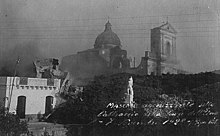
On November 2, 1928, 770 hectares of forest and tropical fruit stocks and 550 buildings in the municipality of Mascali were devastated by lava flows. Other notable outbreaks occurred in 1942 and 1947.
The so far strongest flank eruption in the years 1950–1951 in the Valle del Bove produced around 170 million cubic meters of lava and almost destroyed the villages of Milo and Fornazzo. In 1955 there was an explosive eruption of the northeast crater, which was followed by slow and calm lava outflows at the crater base until 1964. In 1964, several particularly violent eruptions of the central crater were observed, in which the central crater changed its shape and the new crater "La Voragine" was created within the central crater. In March 1968, another new eruption point arose within the central crater, the “Bocca Nuova”, which blew hot gases out with deafening noise for a year and a half.
From April 4, 1971 to May 2, 1971, a lava ejection from Etna destroyed the second section of the cable car and the volcano observatory. On April 5, the first crevices emerged from which the eruptive activity that created the south-east crater developed.
From March 17, 1981, almost 100 meter high lava fountains shot out of a crevice at a height of 2250 meters on the north side of Mount Etna. Lava poured from further deeper crevices and only came to a standstill shortly before the Alcantara River . On March 19, 1981, a lava flow flowed out of a fissure at an altitude of 1,300 meters and threatened Randazzo .
After a series of smaller earthquakes , on March 28, 1983 at 8:45 a.m., a 750-meter-long eruption cracked open on the south side of Etna at an altitude of 2,450 to 2,250 meters , where explosive activity began and lava flows poured out. On the evening of the same day, the lava flooded the road leading up from Nicolosi from the south on a broad front. About 20 buildings were destroyed, including the Ristorante Corsaro, the Hotel Cantoniera, a number of houses on the southern slope and the former Albergo and Ristorante "La Quercia" at an altitude of about 1,300 m. After the reconstruction it is now called “La Nuova Quercia”. The eruption produced 100 million cubic meters of lava, which covered an area of 6 km². The longest lava flow at 7.5 kilometers flowed up to 1080 meters above sea level and came to a standstill seven kilometers before Nicolosi. The 1983 eruption attracted worldwide interest due to the first attempt on a European volcano to deflect the flow of the lava by detonating it .
Accompanied by hundreds of smaller earthquakes , a system of eruption fissures opened on December 14, 1991 at an altitude between 3000 and 2700 meters on the south-eastern flank of the mountain. At the same time, a smaller crack on the north slope of the southeast crater tore open. Violent lava fountains and lava flows came out. In the following night new eruption crevices formed on the northwest wall of the Valle del Bove , from which huge amounts of lava flooded the valley. The lava flow spread to the east over the next few weeks and reached the Val Calanna at the end of the year , very close to the town of Zafferana Etnea .
To protect the city, a protective wall was built at the flat end of the Val Calanna to prevent the lava from flowing down the valley embankment on Zafferana. The lava dam filled for two months, until on April 7th the dam overflowed and the lava swiftly moved up the steep slope towards the city. On its way down, the lava also broke through three hastily erected smaller dam structures. Fortunately, the river stalled just before the city. However, a new lava flow, 120 meters longer, destroyed the first houses in the city in mid-May 1992. After the unsuccessful attempts to stop the lava by dam structures, attempts were made with blasting in order to guide the lava into an artificially created canal. This approach partially led to success. Nevertheless, the necessity of these measures has been questioned in an often polemical way by many conservationists and scientists.
The effusive activity ended on March 30, 1993, after 473 days. This made it the longest lasting flank eruption since the eruption of 1669. The volume of lava flowed out is given as 205 to 250 million cubic meters, the area overflowed by lava as 7.6 square kilometers.
21st century
2001
On July 17, 2001 at 7:00 a.m., an eruption fissure opened at the foot of the southeast crater at an altitude of 2950 meters, in the course of which a series of craters formed, which ejected vivid lava fountains. At 10:00 p.m. the crevice tore further down to a height of 2,700 meters, and lava flowed southwards towards the mountain station of the cable car and ski lifts. When the fissure continued to open up to a height of 2100 meters on July 18, the road connection Nicolosi – Zafferana via Etna-Süd was interrupted over a length of 100 meters by the outflowing lava. Desperate attempts to spray the lava flow with water from the side and thus to stop it, and by building an earth wall, succeeded in rescuing a restaurant threatened by the lava and a souvenir shop at the Etna-Süd station.
On the evening of July 19, a new crater opened at an altitude of 2570 meters. Columns of black ash shot up in violent explosions, dragging large blocks of older volcanic rock with them. On July 24th, the activity of the new crater changed. Lava fountains shot up hundreds of meters with a loud thunder. In the period between July 26th and 30th, enormous efforts were made to save the Etna-Süd station with the Rifugio Sapienza , the valley station of the cable car and the souvenir shops from the lava. Nevertheless, some masts of the cable car were destroyed and the road at the Etna-Süd station was flooded on another stretch. On the evening of July 30th, the mountain station of the cable car went up in flames when a tongue of lava broke through its walls.
It was not until August 9, when the lava flow threatening Nicolosi had already reached a level of around 1050 meters, that the volcano's activity stopped. A total of eight lava flows and mighty ash falls had completely changed an area of 5.5 square kilometers. Around 21 million cubic meters of lava and 20 million cubic meters of pyroclastic material were ejected in the almost 24 days of the eruption.
2002-2003

At midnight on October 26, 2002 eruption fissures opened on the south flank of the mountain at an altitude of 2,750 meters and on the northeast flank at a height of between 2,500 and 1,850 meters, from which lava emerged with great violence. By the end of the eruption on January 28, 2003, the volcano spewed out 60–70 million cubic meters of lava and pyroclastics and caused enormous damage; the cable car was destroyed on the south flank and completely flooded by lava on the north-east flank of the Piano Provenzana with the Etna Nord tourist station.
Before the eruption of 2002, the Piano Provenzana, a wide and flat plateau at an altitude of about 1900 m, was a lovely landscape with trees and grass and flowers. The Etna Nord station with the Le Betulle and Piano Provenzana hotels and a number of wooden huts with souvenir sales and ski rentals were completely destroyed in a short time. The Hotel Piano Provenzana , of which the foundation walls can still be seen today, was not a victim of the flowing lava, but a victim of the strong earthquakes that accompanied the eruption, the falling blocks and bombs and the heat of the passing lava flow.
2004-2008
From September 13, 2004, a wide lava flow emerged on the southeast side of the volcano at an altitude of 2,700 meters, which flowed in the direction of Valle del Bove and, viewed from the highway, produced an impressive spectacle in the dark. Five minor harmless outbreaks were recorded from the summer of 2006, and these outbreaks have become more violent since mid-November. As a result, flights to and from Catania and Calabria were canceled several times at the end of November. From May 11, 2008, there were also several violent eruptions and a period of increased activity.
2012
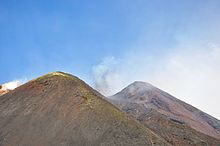
An eruption on January 5, 2012 was followed by other eruptions, but there was no endangerment of the population.
2013
Etna remained quite active in spring 2013, the Strombolian activity on the new southeast crater continued on September 23rd.
On October 26, the volcano threw lava into the air after tremors preceded it. There were no evacuations that day, but large clouds of smoke over the island hindered air traffic.
On the night of November 16-17, Mount Etna erupted again, for the 16th time in 2013 up to this date. The outbreak lasted from about midnight to about 5 a.m. The lava fountains were hurled up to 600 meters into the night sky. Europe's largest and most active volcano has not erupted this big since 1992. There were no dead or injured.
2014
Almost at the same time as the Stromboli eruption in summer 2014, the first paroxysms appeared on Etna volcano from August 3, which led to lava outflows in a northeastern direction. This volcanic activity only subsided in mid-August 2014.
2015
Since October 18th, Mount Etna has been active again. The eruption in the night of December 3, was, according to experts the most violent eruption in recent decades. In a brief but violent eruption, the volcano hurled a fountain of lava and glowing rock into the air. An ash cloud moved northeast towards the major cities of Messina and Reggio Calabria . Air traffic at Reggio Calabria airport was temporarily diverted. The outbreak continued in mid-December.
2017
Lava fountains have appeared on the southeastern crater since an eruption on the evening of February 27. In mid-March there were more powerful eruptions that forced Comiso Airport to take a break in operations. Catania airport had to close on March 18th because of the ash cloud.
2018
On the morning of December 24th from 8:50 am, Etna erupted again. Operations at Catania Airport had to be temporarily suspended. In the first three hours, over 130 light earthquakes with a value of up to 4.0 on the Richter scale were measured.
After the eruption, a 5.1 magnitude earthquake occurred on the morning of December 26, 2018. During the magnitude 4.8 quake, which was later corrected downwards, several people were injured by falling parts of the building. The district of Fleri in the municipality of Zafferana Etnea was particularly affected.
Transport and Access
The street Strada dell 'Etna leads to the Rifugio Sapienza station at 1995 m , which is frequented by many tourists . The cable car, which went from there up to 2600 meters, was destroyed by the eruption in 2002.
The Funivia dell'Etna cable car has been in operation since August 2004 . It leads from 2000 meters to about 2500 meters in altitude; From there, you can continue your journey with all-terrain buses up to a height of around 3000 meters.
Etna can be circumnavigated by train. From Catania a 110-kilometer-long railway line, the Ferrovia Circumetnea , runs almost around the volcano.
The Piano Provenzana on the northeast side of Mount Etna can be reached from the south via the villages of Milo and Fornazzo and from the north via the city of Linguaglossa . The Etna Nord station located there was completely flooded by the lava in 2002 and was later rebuilt.
From Etna Nord (approx. 1800 m slm ), off-road buses drive to the Osservatorio Vulcanologico ("volcanological observation station") at an altitude of 2800 meters.
Winter sports area near Linguaglossa on the northeast slope of Etna
Natural park

The area around Mount Etna, which is characterized by lava stone and therefore extremely fertile, has always had an animal and plant world that can hardly be compared and is unique in Europe in this form. But the rapid development of the area with paved roads and by means of deforestation as well as unrestricted hunting in this area raised great concerns about the continued existence of this habitat, so in 1987 the Parco dell'Etna regional park was established on an area of over 580 km² around Etna .
Postillon on the northern slopes of Etna
Spiegel-Ragwurz on the southern slope of Etna
Black pine on Etna
Large mouse- eared mouse in the Grotta tre Livelli
Etna in literature
The Greek poet Pindar describes Mount Etna in his Epinikia :
“Heavenly pillar […]
The snowy Etna, the year through
wet nurse's sharp flurry.
The purest fountains from his gullies of
the unapproachable fire
, while the rivers pour out the gluten stream of the smoke during the day.
At night, however, the rolling flame, crimson,
carries the rocks roaring in the deep abyss of the sea. "
During his Italian trip, Johann Wolfgang von Goethe also visited Mount Etna in addition to Vesuvius, as the following report shows:
“Catania, Saturday, May 5th 1787.
[…] the masses of lava in the foreground, the double summit of Monte Rosso on the left, just above us the forests of Nicolosi , from which the snow-covered, little smoking summit rose. We moved closer to the red mountain, I climbed it: it is made entirely of red volcanic gravel, ashes and stones. It would have been easy to walk around the estuary if a violent morning wind had not made every step unsafe; if I only wanted to get away somewhat, I had to take off my coat, but now the hat was in danger of being driven into the crater at any moment, and I would be behind. So I sat down to compose myself and look over the area; but this situation did not help me either: the storm came straight from the east over the wonderful land that lay near and far to the sea below me. "
"17th [May 1804] Ascent to Etna. [...] Before midnight the voice of the guide woke us on the way to the top of the mountain, which we wanted to reach when the sun rose. […] The trees gradually disappeared, the cinder from the lava that had flowed out piled up more powerfully and could only be climbed with caution. There was deep silence all around, only in long pauses the wolf called up from the lower forests. […] The sun rose when we reached the few ruins of the so-called Tower of Empedocles, […] the way to the edge is difficult. The cone is smooth and surrounded by a snow bark that makes you fall with every step. The approach was extremely sensitive, a wind drove the sulfur vapor to all sides, we were only able to overlook the two depressions of the crater for a few minutes. I found that of Vesuvius to be much larger and more impressive. Etna, which has 36 smaller volcanoes around it, often remains completely calm during eruptions at the summit, as the eruption at Vesuvius is accompanied by a violent fire from the crater. "
literature
- Christian Hülsen : Aitne 1 . In: Paulys Realencyclopadie der classischen Antiquity Science (RE). Volume I, 1, Stuttgart 1893, Col. 1111 f.
- Hans Pichler: Italian volcanic areas IV, Etna, Sicily . In: Collection of geological guides (vol. 76) Gebr. Bornträger, Stuttgart 1984. ISBN 3-443-15037-3
- Hans Pichler, Rolf Schick: The Etna . In: Volcanism - force of nature, climatic factor and cosmic form power . Spectrum of Science: Understandable Research, Spectrum-der-Wissenschaft-Verlagsgesellschaft, Heidelberg, 1985. ISBN 3-922508-32-4
- Emilia Poli Marchese: Piante e fiori dell'Etna . Sellerio editore Palermo, 1991, ISBN 88-7681-046-3 .
- Haroun Tazieff: Etna, the mountain - its dangers - its future . BusseSeewald, Herford 1988. ISBN 3-512-00817-8
- Chris Kilburn, Bill McGuire: Italian volcanoes. Classic Geology in Europe 1. Terra, Harpenden 2001. ISBN 1-903544-04-1
- DK Chester, Angus Duncan, JE Guest, C. Kilburn: Mount Etna: The anatomy of a volcano . Springer Science & Business Media, 2012, ISBN 978-94-010-8309-6 ( limited preview in the Google book search [accessed December 20, 2015] Paperback reprint of the original edition from 1985).
Web links
- Parco dell'Etna website (Italian, English)
- Parco dell'Etna in the portal of the Italian national and regional parks (Italian, English)
Photos and videos
- Live video from Linguaglossa Etna Nord
- Video from the volcanologist Boris Behncke about the paroxysm from March 2013
- Photo and description of the 1981 Randazzo eruption
Scientific websites
- Istituto Nazionale di Geofisica e Vulcanologia (INGV) (Italian / English)
- Etna in the Global Volcanism Program of the Smithsonian Institution (English)
Summary description of the volcano and its development
- B. Behncke: Etna Week (Part 1) - Brief Anatomy of an Exceptional Volcano , Wired Science Blogs, Eruptions , August 16, 2010 (English)
- B. Behncke: Etna Week (Part 2) - The Current Dynamics and Activity of Etna , Wired Science Blogs, Eruptions , August 18, 2010 (English)
- B. Behncke: Etna Week (Part 3) - Etna's Volcanic Hazards , Wired Science Blogs, Eruptions , August 20, 2010 (English)
Reports of the volcanological institute INGV Catania on the current activity of Etna
- Report on paroxysms in February 2013, INGV Catania (English)
- Etna and Stromboli activity report, February 27–2. March 2013, INGV Catania (English)
- Report on the paroxysm from 5. – 6. March 2013, INGV Catania (English)
- Report on the paroxysm of March 16, 2013, INGV Catania (English)
- Report on the paroxysm of April 3, 2013, INGV Catania (English)
Etna in historical texts and pictures
Individual evidence
- ↑ Mount Etna and the Mountains of Pamir inscribed on World Heritage List alongside El Pinacate and Gran Desierto de Altar , UNESCO World Heritage Center from June 21, 2013
- ^ Antonio Sciarretta: Antonio Sciarretta's Toponymy - Ancient Toponymy. May 24, 2003, archived from the original on December 23, 2015 ; accessed on December 23, 2015 .
- ↑ For the designation in the 14th century see Petrarcas Canzoniere , 42, 5-8: ch'a Giove tolte son l'arme di mano / temprate in Mongibello a tutte prove, / e sua sorella par che si rinove / nel bel guardo d 'Apollo a mano a mano. ; for a reference at the beginning of the 16th century see Ariosts Orlando furioso , Cantus I, XL: Sospirando piangea, tal ch'un ruscello / parean le guancie, e 'l petto un Mongibello.
- ^ Kilburn et al .: Mount Etna: The anatomy of a volcano. , 1985
- ↑ Stefano BRANCA, Mauro COLTELLI, Gianluca GROPPELLI, Fabio LENTINI: GEOLOGICAL MAP OF ETNA VOLCANO. (PDF) INGG, 2011, accessed on December 23, 2015 (English).
- ^ Evoluzione geologica del Monte Etna - Fase delle Tholeiiti Basali (German: Geological development of the Etna volcano - Tholeiiti phase ) , accessed June 14, 2011
- ↑ Mount Etna volcano, Sicily (English) (German: Der Vulkanberg Etna, Sicily ) Accessed: June 14, 2011
- ↑ Tsunami: Landslide devastated the Mediterranean Sea 8,000 years ago . ( innovations-report.de [accessed on October 17, 2016]).
- ↑ Marc Szeglat: Valle del Bove Etna. In: www.vulkane.net. Retrieved October 17, 2016 .
- ^ Gravitational collapse of Mount Etna's southeastern flank
- ↑ Popular scientific presentation
- ↑ Gravitational Sliding of Mt. Etna massif along a sloping basement 2018
- ↑ Etna mythology as presented by the Institute for Roman Law at the University of Cologne , accessed on November 9, 2011
- ↑ Dante, Divine Comedy , Inferno 14:56: "in Mongibello alla fucina negra"
- ^ Karl Gratzl: Myth Mountain. Lexicon of the important mountains from mythology, cultural history and religion . Hollinek, Purkersdorf 2000, ISBN 3-85119-280-X , p. 39-42 .
- ↑ Diodor , Bibliothéke historiké 5, 6, 3.
- ^ GF Rodwell, Etna: A History of the Mountain and Its Eruptions (1878), reprinted Cambridge University Press 2011, pp. 79f.
- ↑ Moses I. Finley, The ancient Sicily. From prehistory to the Arab conquest (Beck, Munich 1979), p. 31f.
- ↑ Thucydides : History of the Peloponnesian War III, 116: “The stream of fire poured out of Etna that same spring as it did earlier. He devastated a piece of land in Katania, which lies at the foot of Mount Etna, the largest mountain in Sicily. It is said that it was fifty years from the previous eruption to the present one, and that there have been three eruptions in total since Sicily was colonized by the Hellenes. ”(Translation by Georg Peter Landmann )
- ↑ Round trip on Etna: from Serracozzo to the Sartorius craters. March 23, 2020, accessed on March 29, 2020 (German).
- ↑ Etna spits 5000 meters high ash column. Spiegel Online , January 5, 2012.
- ↑ Etna Activity 2012. go-etna.de 12 April 2012th
- ↑ Volcanic eruption in Sicily: Scientists give the all-clear after the recent eruption of Etna. ARD Tagesschau (minute 1:15 p.m.), April 13, 2012.
- ↑ Etna Updates 2013 , vulkan-etna-update.de (accessed on March 6, 2015).
- ↑ Etna volcano erupted , ORF.at of October 26, 2013
- ^ Sicily - Etna spits fire ( memento from November 22, 2013 in the Internet Archive ), sueddeutsche.de from November 17, 2013
- ^ Tilmann Kleinjung: Etna eruption in Sicily: Lava fountains and ash rain. In: Tagesschau.de . December 3, 2015, accessed December 4, 2015 .
- ↑ “Short but violent eruption”: Etna hinders air traffic. In: N24 .de. December 4, 2015, accessed December 4, 2015 .
- ^ INGV , accessed December 20, 2015
- ↑ http://www.livescience.com/58046-mount-etna-volcano-eruption.html
- ↑ Etna volcano erupted in Sicily: ten injured , derstandard.at, March 17, 2017.
- ↑ Sicily. Catania airport closed due to Etna eruption. Spon March 18, 2017.
- ↑ Nuova attività dell'Etna - December 24, 2018. In: comunicazione.ingv.it . December 24, 2018, accessed December 24, 2018 (Italian).
- ↑ earthquake.usgs.gov (English) accessed on December 26, 2018
- ^ Etna, terremoto di magnitudo 4.8 a Catania. Paura nella notte: crollano case, 10 feriti, gente in strada. In: La Repubblica .it. December 26, 2018, accessed December 26, 2018 (Italian).
- ^ Pindar, 1st Pythian Ode , 20–24. Translation: Alexander Schenk Graf von Stauffenberg in: Alexander Schenk Graf v. Stauffenberg, Trinakria . Oldenbourg Verlag, Munich – Vienna, 1963. p. 265
- ↑ Goethe and Etna on the homepage of the Goethe Society , accessed on October 23, 2011
- ↑ Gottfried Riemann (Ed.): Karl Friedrich Schinkel - Travel to Italy. First voyage 1803–1805. 1st edition, Aufbau-Verlag, Berlin and Weimar 1994, ISBN 3-351-02269-7

